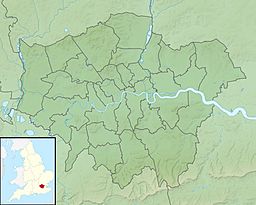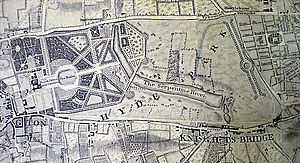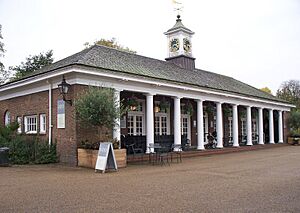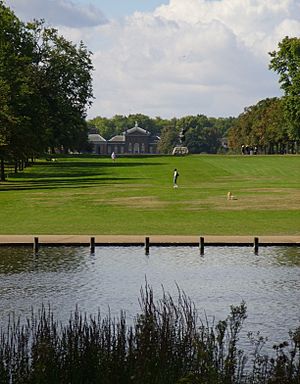The Serpentine facts for kids
Quick facts for kids Serpentine |
|
|---|---|

Serpentine Bridge from Kensington Gardens
|
|
| Location | London, England |
| Coordinates | 51°30′19″N 0°10′10″W / 51.50528°N 0.16944°W |
| Type | Artificial lake, created 1730 |
| Primary inflows | Three boreholes from the upper chalk |
| Primary outflows | Storm Relief Sewer |
| Basin countries | United Kingdom |
| Surface area | 16.2 ha (40 acres) |
| Max. depth | 5.30 m (17.4 ft), 2012 data |
| Water volume | max 393,700 cubic metres (319.2 acre⋅ft) at 14.96 m (49.1 ft) AOD |
| Residence time | 10 years before 2012, 5 months after May 2012 |
| Islands | 1 |
The Serpentine is a large, 40-acre (16 ha) lake in Hyde Park, London, England. It was created in 1730 for Queen Caroline. While many people call the whole lake "The Serpentine," the name actually refers to only the eastern part. The Serpentine Bridge separates it from the western part, which is called the Long Water. The lake gets its name from its slightly curvy, "snake-like" shape.
The Serpentine was once fed by rivers, but now it gets its water from three special wells deep underground. These wells were put in place in 2012 to keep the lake fresh and clean. The lake has been a central spot for big events, like The Great Exhibition in 1851. It also hosted the swimming events for the London 2012 Olympics. Every Christmas morning since 1864, the Serpentine Swimming Club holds a 100-yard race. In 1913, J. M. Barrie, the writer of Peter Pan, started the Peter Pan Cup for this race.
You can find many fun things to do around the Serpentine, including boating on the lake itself. A famous landmark nearby is the Diana, Princess of Wales Memorial Fountain.
Contents
How the Lake Was Formed
The Serpentine was created in 1730 when Queen Caroline, the wife of King George II, ordered a dam to be built. This dam blocked the River Westbourne in Hyde Park. Before this, the Westbourne River flowed through the park, forming several small ponds. These ponds were then connected and reshaped to create the single, large lake we see today.
At the time, most artificial lakes were made long and straight. The Serpentine was special because it was one of the first lakes designed to look natural. Its curvy shape was later copied in many other parks and gardens across the country.
The Serpentine's Water Source
The Serpentine used to get its water from the River Westbourne. However, by 1834, the river became too polluted. For some years, water was pumped into the lake from the River Thames. Today, the lake is supplied by three special wells, called boreholes, that go deep into the ground.
One borehole is near the Italian Garden, and another is by the Diana Memorial. The third was drilled in 2012 and goes down 132 m (433 ft)! These boreholes provide a lot of clean water, keeping the lake fresh.
Exploring the Lake's Sections

The Serpentine is divided into two main parts by the Serpentine Bridge. The western part, which is long and narrow, is called the Long Water. The eastern part, which curves more, is known as the Serpentine.
Water flows out of the eastern end of the lake through a special gate called a sluice. This creates a small, pretty waterfall at a spot called the Dell. In the past, the waterfall sometimes dried up, but after a big restoration project in 2012, it flows well again.
The lake is about 17 ft (5.2 m) deep at its deepest point. There are also two restaurants by the lake and many fun activities along its shores.
Big Events at the Serpentine
The Serpentine has been a popular place for big events throughout history. In 1814, it was part of celebrations marking 100 years of the Hanoverian royal family. It also played a key role in The Great Exhibition of 1851, with the famous Crystal Palace standing on its southern shore.
Later, large events stopped happening on the lake's banks. However, the Serpentine was used for the Queen Elizabeth II's Silver Jubilee celebrations in 1977. It was also a very important venue for the 2012 Olympics, hosting the triathlon and marathon swimming races.
Restoring the Lake's Health
In 2011, a big project began to restore the Serpentine. People were worried about the water quality and the health of the lake's environment. This project made a huge difference in how water flows through the lake. Before, it took 10 years for all the water in the lake to be replaced. Now, with the new boreholes, it takes only 4 to 5 months!
The project also cleaned up old dirt and pollution from the bottom of the lake. Special pumps were installed at the bottom to add oxygen to the water and keep it mixed. This helps prevent stress for the plants and animals living in the lake. Some large fish were also moved in 2012 to help the lake's plants grow better. These changes made the water quality excellent, which was perfect for the Olympic swimming events in 2012.
Fun Things to Do at the Serpentine
Swimming
A special swimming area called Lansbury's Lido opened on the southern bank in 1930. It's separated from the rest of the lake by buoys. You need to pay a small fee to enter, and there are changing rooms available. The lido is usually open in the summer, from 10:00 AM to 5:30 PM.
However, members of the Serpentine Swimming Club can swim all year round, from 5:00 AM to 9:30 AM. The famous Peter Pan Christmas Day Race is only for people who regularly swim in the club's Saturday competitions during the winter.
The Serpentine was the perfect spot for the swimming parts of the Olympic triathlon and the marathon swimming events during the 2012 Olympic Games. There's also a two-day open water swimming event called Swim Serpentine, organized by the London Marathon team.
The Peter Pan Cup Race

Since 1864, a 100-yard (91.4 m) swimming race has been held every Christmas morning at 9 AM. In 1904, the famous author J. M. Barrie, who created Peter Pan, started giving a special prize called the Peter Pan Cup to the winner. This tradition continues today! Because swimming in freezing water can be dangerous, only members of the Serpentine Swimming Club are allowed to join this race.
Boating
You can rent rowing boats to enjoy the Serpentine. In 2002, the lake even hosted the Mercedes Benz World Rowing Sprints, where international rowing teams raced over 500 metres (547 yards).
Solarshuttle
During the summer, you can take a ride on the Solarshuttle. This boat is powered completely by the sun! It carries up to 42 passengers and travels between the northern and southern banks of the Serpentine. At 48 feet (15 m) long, it's the biggest solar-powered passenger boat in the UK.
Famous Places Near the Serpentine
The Hyde Park Holocaust Memorial, opened in 1983, stands at the eastern end of the Serpentine. It's a place to remember those who suffered during the Holocaust. On the northern shore, there's another memorial put up by Norwegian sailors in 1978. They built it to thank Britain for giving them a safe place during World War II.
The Diana, Princess of Wales Memorial Fountain, which opened in 2004, is on the southern shore. Even though it had some issues at first, it's now one of the UK's most popular attractions, with many visitors each year. Nearby are the Serpentine Gallery and the Serpentine Sackler Gallery, which opened in 2013 in a building that used to be a gunpowder storage.
On the northern side of the lake, across from the Lido, are two boathouses. The East Boat House was built in 1903, and the West Boat House in 1952. Close by is a grassy area called the Cockpit. This used to be a gravel pit and was the site of The Rolling Stones' famous "Stones in the Park" concert in 1969. This area also appears in the 1953 film Genevieve, as the starting point for the annual London to Brighton Veteran Car Run.
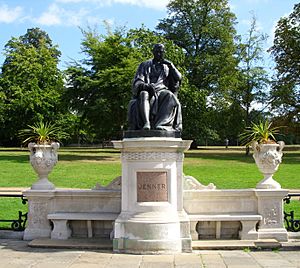
Images for kids
-
The modernist architecture of the Dell Restaurant, situated on the northern end of the dam, dominates the eastern end of the lake.
See also
 In Spanish: Lago Serpentine para niños
In Spanish: Lago Serpentine para niños


